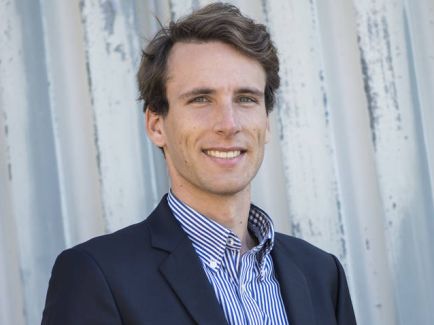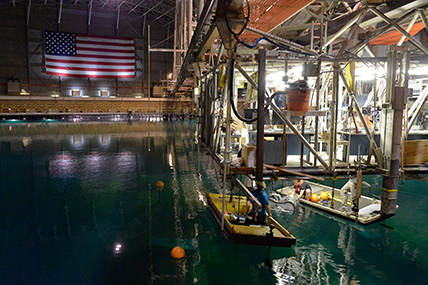Generating energy from ocean waves
Marcus Lehmann spent eight months at the Fraunhofer-Gesellschaft headquarters in Munich from the end of 2011. Today he runs a company that could make a decisive contribution to humanity's energy supply in the future. The company CalWave Power Technologies Inc., which was co-founded by the Fraunhofer alumnus and which he also chairs as CEO, is developing a power plant that generates electricity from ocean waves. In comparison to wind or solar energy, this process offers various advantages. If the energy of all ocean waves could be captured it would be possible to produce the amount of energy that was consumed worldwide in the entire year of 2008. It is estimated that by 2050 up to 10 percent of Europe's electricity requirements could realistically be covered by energy from the sea.
The power plants of the young Californian enterprise float under the ocean's surface some distance away from the coastline. This has several advantages: Unlike wind turbines, these plants are under water and thus not visible. They can produce energy even during storms and do not depend on sun and wind. Above all, however, the energy yields from these power plants can be reliably predicted over a long period of time. CalWave Power Technologies was runner up to the U.S. Department of Energy's Wave Energy Prize and is a project of Cyclotron Road, a start-up incubator from the Lawrence Berkeley National Laboratory.
Fraunhofer-Alumni e.V.: Mr. Lehmann, how did you find your current position?
I read an article about waves in the MIT Technology Review while I was at the Center for Digital Technology and Management (CDTM) waiting to be accepted as an exchange student. The CDTM is an initiative of the Ludwig Maximilian University and the Technical University of Munich (TUM) which offers the postgraduate course "Technology Management" and is part of the Elite Network Bavaria. As a visiting research student at CDTM, I suggested using this technology as a project for my thesis in mechanical engineering at the TUM. We already registered our first patent while I was working on the project. After completing my degree and my work at CDTM, I returned to Berkeley as an external doctorate student with the Technical University of Hamburg-Harburg. There I successfully took the initiative to suggest the use of this technology to Cyclotron Road. We have been an independent company since 2017, but have continued to work together with the Theoretical and Applied Fluid Dynamics Laboratory (TAFLab) of the University of Berkeley. The TAFLab is run by Professor Reza Alam, who also created the original concept.
Fraunhofer-Alumni e.V.: Through Cyclotron Road, start-ups receive financial support as well as access to resources of the Lawrence Berkeley National Laboratories. In your opinion, how far advanced is the project?
In 2012, we built our first prototype together with fellow students with what we could find in the laboratory. Since then, the project has developed significantly. In terms of NASA's 9-level Technology Readiness Level system, we are between 4 and 5 at the moment. This means that we are already testing prototypes and carrying out the first scaling experiments.
We are currently funded by the U.S. Department of Energy and have a 48-month contract. We are therefore planning up to the year 2020 and are expecting that we will need another year to extensively test the technology. Theoretically, we could go into serial production in 2021.
Fraunhofer-Alumni e.V.: Could you please give us more insight into this technology?
The original concept is derived from mud vibrations. There are areas in the oceans where the muddy seabed works like a distributed shock absorber. In depths of just a few meters, the muddy seabed can quickly absorb the wave energy. The U.S. Department of Energy was looking for concepts on how to use this energy to generate electricity and sponsored a nationwide competition. With our proposal, we were able to win the competition prize money.
However, we are not installing our system in coastal areas where the waves have already released a lot of energy, but further offshore. There the waves are longer and have more energy. Concepts closer to the coastline look simpler at first; however, the waves already have double the energy one kilometer off the coast.
Offshore power plants need a special anchoring system to keep the technology floating under water. As the water is quite deep further offshore we need to use these special anchors. This also has advantages, because we do not have any visual impairments. It also makes it possible to withstand heavy storms such as we know from the pitch and yaw regulation of a wind turbine.
Fraunhofer-Alumni e.V.: Have you already installed the power plant anywhere?
Over the last four years, we have conducted several tank test campaigns in laboratories to validate our numerical models and optimize efficiency and cost structures. Since 2017, we have been working on a pilot project to be tested in the open sea in 2020.
Fraunhofer-Alumni e.V.: How high is the energy yield compared to other renewable technologies?
According to Ocean Energy Europe, the industry plans to install 100GW of capacity, equivalent to 10 percent of demand.
Moreover, wave energy offers further advantages: Due to the higher energy density, marine power plants require a much smaller area. In addition, these devices can be placed closer to the coast than an offshore wind farm, which simplifies maintenance. And we also don't have a transition from water to air. In a classic offshore wind farm, high loads act on the anchors and you have to deal with other problems, such as rust. Because we are completely under water, we can also produce electricity under stormy conditions.
Fraunhofer-Alumni e.V.: What potential do you personally see in wave energy?
If we want to achieve the goal of a 100 percent renewable energy, we need to diversify. And this is where wave energy can make a major contribution. That is because the variation here takes place on an annual basis. With this concept there are no fluctuations between day and night, such as with solar power, or changes in the range of a few seconds, such as with wind energy. The expected yield can be calculated relatively precisely up to two weeks in advance. Our prime example here is Hawaii, which covers approx. 27 percent of its energy needs with renewable energy – practically only using wind and solar energy. Here, wave energy could make a decisive contribution.
Fraunhofer-Alumni e.V.: Did your work at Fraunhofer prepare you for your current task?
I started in December 2012 as a working student in the staff of CFO Alfred Gossner. There I worked for Dirk Artels who continued with his research in addition to his job. I also supported him with that work too.
Dirk's program at that time was headed in the direction of Fraunhofer Venture. But he was dedicated to the question of how fundamentally new technologies can really be brought to market maturity. I have always relied on this special Fraunhofer Stage Gate model in my work for Cyclotron Road. Not only because I came from Fraunhofer, but also because it was the only analogous model worldwide at that time. I also had a major in product development where I wrote business plans, among other things. This combination was a very good bridge for my current activity.
Fraunhofer-Alumni e.V.: What was of particular interest to you at Fraunhofer?
During my studies and at secondary school I was always a diligent reader of various scientific publications. I also read "weiter.vorn" on a regular basis at the time. I have always been particularly fascinated by Fraunhofer and how they put basic research into application. This has shaped me to such an extent that I also pushed my professional development in this direction. If the current project hadn't materialized, Fraunhofer would certainly have been an alternative.
Fraunhofer-Alumni e.V.: Do you still have contact to Fraunhofer and use the Alumni e.V.?
Dirk Artels is still my main contact. In the meantime, however, he has also founded a spin-off and works for a small family business. I had also worked with Dr. Gunnar Brink on the central theme of the company foundation. In the meantime, Dr. Brink heads the Arggonauts diving drones project. Another colleague at the time was Daniel Strohmayr, who was co-founder and CEO of the start-up Tacterion and raised millions of euros in funding.
Fraunhofer-Alumni e.V.: Why are you with Alumni e.V.?
I have always been fascinated by Fraunhofer and especially by the impressive results. And Professor Eike Weber, former director of the Fraunhofer Institute for Solar Energy Systems ISE in Freiburg, is still an inspiration for me. Even today, the ISE is still the world leader in the efficiency of solar cells.
With our project, we are increasingly operating in an industrial environment and Germany is still very strongly positioned in this respect. Numerous suppliers for Calwave come from Germany, just as our software comes from Germany. It's important for me to have a connection, too.
Fraunhofer-Alumni e.V.: What would you like the Fraunhofer-Alumni e.V. to do?
It is always important for us to find mentors. In contrast to a software startup, for example, where mentoring is relatively common, role models are missing in our area. Especially in industrial sectors, large amounts of knowledge are passed on implicitly. Since we are still a young team, we currently have no one who has had several years of experience in this field.
I am certain that an expert with experience in the industrial environment could give us a lot of support. At first glance, the term "mentor" sounds like a lot of work. Basically, however, it is enough to answer an e-mail twice a year, talk on the phone for 20 minutes or have an opinion on an issue.
Fraunhofer-Alumni e.V.: Perhaps you will find a suitable candidate among your Fraunhofer alumni colleagues. Thank you for the interview, Mr. Lehmann. We wish you great success.
- If you would like to support Mr. Lehmann, please contact Martin Schindler via e-mail.

